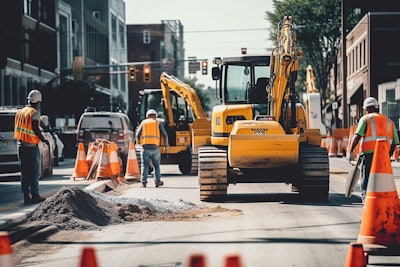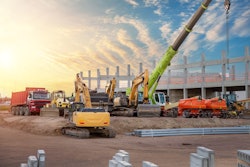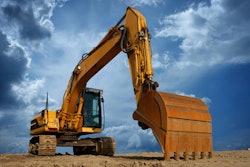
In the dynamic world of highway and off-highway workspaces, where massive machinery and complex work site components abound, safety is paramount. These environments can pose significant risks, with mobile equipment operating in close proximity to bustling crews, moving traffic, valuable property and vulnerable pedestrians.
The National Safety Council (NSC), citing Bureau of Labor Statistics (BLS) and National Highway Traffic Safety Administration (NHTSA) data, reports that in 2021 more than 900 people were killed and over 42,000 injured in work zone crashes.1 Of the 954 total fatalities:
- 468 were in construction zones.
- 66 were in maintenance zones.
- 17 were in a utility zone.
- 403 were in work zones of unknown type.
Disturbingly, work zone deaths have surged by 63% since 2010, emphasizing the pressing need for drivers to exercise caution and for innovative technologies and targeted training to be implemented that can significantly reduce the number of accidents occurring in these hazardous work environments.
Safety Gets an Assist
Take a closer look and you will discover a number of product innovations that are making job sites safer for crews and equipment operators. Companies that manage construction activities or that supervise work zones are encouraged to explore the newest apparatuses, tools and instruments that can do more to protect people, property and progress:
- Autonomous flaggers
Better known as AFADs, Automated Flagger Assistance Devices provide an effective alternative to traditional flagging operations. The technology has existed for several years; however, use of AFADs on America’s roadways is just now becoming widespread as more companies come to know the benefits.
AFADs are “smart” traffic control systems that provide temporary measures that indicate to motorists where and when to slow down. Most are composed of a series of sensors installed in the device and/or within the work zone, along with a visual indicator such as a flag or light. The sensors detect a vehicle’s speed and transmit the data back to the indicator. When a vehicle enters the work zone, the indicator warns the motorist to slow down and/or activates the device’s flagging arm.
These systems have proven to be highly effective in reducing crash risks in work zones. A 2017 study by the Missouri DOT found that motorists were more responsive to AFADs and that 78% of drivers prefer AFADs over human flaggers.2
Units are typically controlled by trained and certified flaggers via a roadside tablet and operate on a secure LAN so they can work anytime, anywhere. Some AFADs also make use of onboard Google/Waze technology to divert a certain volume of traffic around the work zone entirely. And should a vehicle breach the work zone, AFADs can instantly sound an alarm to alert people to the danger.
It is believed that with further advances some AFAD systems will even be able to detect and analyze a driver’s behavior as vehicles approach the work zone, then alert crews to any potentially dangerous activity. This could lead to a significant reduction in the number of injuries and fatalities that occur annually in work zones.
- Portable temporary rumble strips (PTRS)
PTRS are an often overlooked solution for managing traffic flow, and the use of rumble strips is now required by many states in work zones. These plastic or polymer strips create a groove-like effect over asphalt or concrete surfaces and are relatively inexpensive compared to traditional traffic control measures.
The relatively small size and light weight of these temporary strips make them ideal for use at road construction sites as a cost-effective alternative to installing traditional rumble strips.
- Cushioned impact attenuators
Cushioned impact attenuators or “crash cushions” are also increasingly used as temporary installations to protect motorists and construction workers. Among these are fully redirective, nongating, bidirectional attenuators that can be attached to most types of roadside barriers to automatically regulate the stopping force exerted on a vehicle as well as lessen the risk of a vehicle rebounding after impact.
National Cooperative Highway Research Program (NCHRP) crash performance testing shows that crash cushions are breaking new ground in significantly lowering vehicle deceleration rates and reducing impact forces.
Cushioned attenuators allow lighter and slower-moving vehicles to have longer ride-down distances and lower ride-down G-forces. Unlike fixed-resistance attenuators, a cushioned attenuator does not reach maximum stopping resistance unless a vehicle is traveling at the maximum design speed. These may also be designed to create an extremely low angle of exit on side impacts, thus helping to keep vehicles from rebounding back into traffic and causing secondary accidents.
Training That Saves Lives
Ultimately it is training that equips construction crews and vehicle operators with the knowledge and personal duty to practice work zone safety. Traffic control plans should prioritize steps for training and education activities that teach constant alertness and cautious driving habits in work zones.
A variety of focused training programs are available to companies whose employees work in, or otherwise manage, active construction zones. Notable are programs available through organizations like the National Safety Council and National Work Zone Safety Information Clearinghouse. Courses can range from designing work zones to project coordination training to using smart traffic control technologies. Employees can take courses to improve their knowledge and understanding in specific construction environments, and supervisors can track the progress of individual students to ensure that they are prepared to carry out their duties safely.
Comprehensive coursework, real-life scenario modeling and peer-to-peer coaching help to achieve a higher safety standard that can often exceed federal and local requirements. Every member of the field team assigned to a work site should have completed work zone safety training including first aid and CPR and in the case of those actually monitoring traffic, certified flagger training as well. The FHWA maintains a robust work zone management program offering nationally available and state-specific training opportunities.
For anyone operating a vehicle in a work zone, state-specific DOT training is required. Safety decision- makers may also consider advanced driver training and tools for their fleets. These programs can help to develop skills such as anticipation, decision-making and vigilance, all of which can help drivers avoid potential accidents.
Work Zone Safety Never Stops
For construction crews and equipment operators, the best defense against dangerous driving habits remains a properly designed and implemented work zone staffed by certified safety professionals. Today’s technologies can elevate job site safety to new levels, and focused training programs can equip personnel with the special skills needed to stay alert and know their route of escape in an emergency.
There are professional traffic control services providers operating in all parts of the country that have the knowledge to ensure work zones are fully compliant with federal and local requirements, so be sure to investigate opportunities in your area. In the pursuit of safer environments, the collaboration between skilled professionals and cutting-edge technology paves the way for work zones that prioritize both efficiency and the protection of lives.




















